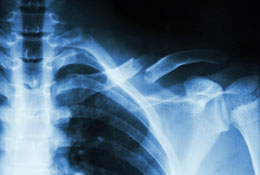Surgery is performed in case of severe clavicle fracture, where regular treatment methods fail to correct the condition. This mainly involves the use of pins, screws, and plates to hold bones in normal positions.

The clavicle, also known as collarbone, is an important part of the skeletal system. This bone is located on each side of the front, upper region of the chest, and lies between the scapula (shoulder bone) and sternum (breastbone). Unlike other bones in the body, it is only covered with skin and is clearly visible. An injury caused due to a fall, or a blow on the shoulder/collarbone can result in clavicle fracture. It is a common sports injury and being affected by it, or any bone fracture in general, can be extremely distressing, as it not only hampers the daily routine but also makes the experience quite painful. In case the nature of the injury is severe, the doctor may opt for surgery.
Fracture Indications
Clavicle fracture is usually a result of injury or trauma. If any of the following indications are frequently observed, then the doctor may advise the patient to undergo surgery.
- One of the most common indications is experiencing pain, which can be quite excruciating. In some cases, sharp pain may be triggered even when slight movement is made.
- Swelling in the affected region; often, the fracture can be felt through the skin after the swelling reduces.
- Bruises may also be seen on the surface as a result of ruptured blood vessels.
- Nausea and dizziness due to extreme pain
Treatment
Depending on the severity and nature of the injury, treatment can be either surgical or nonsurgical. Many a time, this injury may be treated with the help of a sling, where the movement of the hand becomes restricted till it heals completely. Surgery is opted only when the skin is torn, or the bone is completely dislocated from its joint. Painkillers may be prescribed to relieve pain in and around clavicle area. Antibiotics may also be prescribed to ward off any kind of infection. In case the injury is severe, surgery is performed.
Before the surgery, the orthopedic may conduct a series of diagnostic tests like X-ray to check, if any one of the nerves is ruptured. A CT scan may also be required for closer examination of the broken bone. Other tests may include physical examination and blood tests. For treatment through surgical methods, the patient is made to sit in a beach-chair position. Local anesthesia is administered so that the person does not experience pain during the procedure. Then, with the help of a scalpel, the injured region is opened and the wound is cleaned. A guide pin is drilled on both the broken ends of the clavicle to secure them. In order to fix the fractured bone, a cannulated screw and washer are attached to the collarbone at the medial end of the cortex. Once this procedure is completed, the incision is closed by suturing, and a bandage is wrapped around the area to prevent infections. The arm is then cast in a sling till the condition returns back to normal. The fixture of a plate in the collarbone allows early rehabilitation.
The surgery recovery time for clavicle fractures is determined considering various factors, such as extent of the injury, age of the individual, and his/her response to the treatment administered. For the injury to heal completely, it can take approximately twelve weeks. Undergoing physical therapy also helps speed up the recovery process.
Disclaimer: The information provided in this article is solely for educating the reader. It is not intended to be a substitute for the advice of a medical expert.


 The clavicle, also known as collarbone, is an important part of the skeletal system. This bone is located on each side of the front, upper region of the chest, and lies between the scapula (shoulder bone) and sternum (breastbone). Unlike other bones in the body, it is only covered with skin and is clearly visible. An injury caused due to a fall, or a blow on the shoulder/collarbone can result in clavicle fracture. It is a common sports injury and being affected by it, or any bone fracture in general, can be extremely distressing, as it not only hampers the daily routine but also makes the experience quite painful. In case the nature of the injury is severe, the doctor may opt for surgery.
The clavicle, also known as collarbone, is an important part of the skeletal system. This bone is located on each side of the front, upper region of the chest, and lies between the scapula (shoulder bone) and sternum (breastbone). Unlike other bones in the body, it is only covered with skin and is clearly visible. An injury caused due to a fall, or a blow on the shoulder/collarbone can result in clavicle fracture. It is a common sports injury and being affected by it, or any bone fracture in general, can be extremely distressing, as it not only hampers the daily routine but also makes the experience quite painful. In case the nature of the injury is severe, the doctor may opt for surgery.